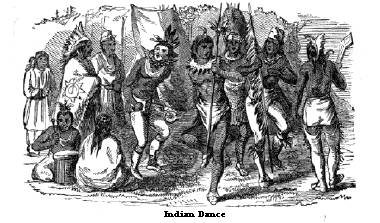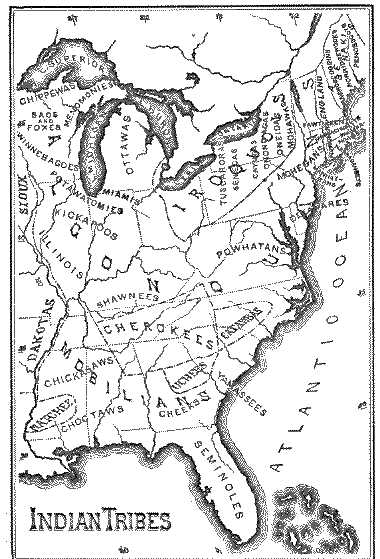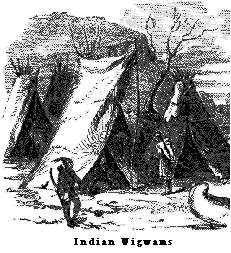Resource Center OLLibrary
|
22 |
|
4. The
amusements of the men were principally leaping, shooting at
a mark, dancing, and gaming. Their dances were usually performed
round a large fire. In their war dances they sung or recited the
feats

which they or their ancestors had achieved, represented the
manner in which they were performed, and wrought themselves up to
an inexpressible degree of martial enthusiasm.
Important tribes included in each; also, their locations at a time but little subsequent to the close of this period: --
I. The, IROQUOIS, or WYANDOTS, occupying the northern part of the state of New York, and extending from the Hudson to Lake Erie. 'This family included, 1. The MOHAWKS; 2. The ONEIDAS; 3. the ONONDAGAS; 4. The CAYUGAS; 5. The SENECAS. This confederacy was called the FIVE NATIONS. At a later period, in 1713, they were joined by a kindred tribe from North Carolina and Virginia, the TUSCARORAS, and were called the SIX NATIONS. This family also occupied territory in Canada, north of the St. Lawrence and Lakes Ontario and Erie.
II. The ALGONQUINS.--Their territory extended entirely around that of the Iroquois. Their principal divisions in the United States were, 1. The ABENAKIS, occupying nearly all the present State of Maine and part of New Hampshire. and including the Penobscots, the Norridgewocks, and the Androscoggins, whose locations are marked very nearly by the rivers named for them. -- 2. The NEW ENGLAND INDIANS, extending from New Hampshire to Connecticut, and including the Pawtuckets, located near the mouth of the Merrimac; the Massachusetts, about the bay of the same name; the Wampanoags, or Pokanokets, occupying the South-eastern part of Massachusetts and the eastern part of Rhode Island; and the Narragansets, west if Narraganset Bay. -- 3. The MOHEGAN TRIBES, extending from the eastern part of Connecticut to New Jersey, and including the Pequods, east of the Connecticut; the Mohegans proper, west of the Connecticut, and the Manhattans, occupying the Island of Manhattan, on which the city of New York now stands, and portions of the surrounding country. -- 4. The LENNI LENAPE, best known by the name of one of their principal tribes, the Delawares, In the valley of the Delaware. -- 5. The POWHATANS, occupying the low lands between the James and the Potomac. -- 6. The SHAWNEES, a roving tribe, but first met with in Tennessee, between the Ohio and the Cumberland Rivers. -- 7. The ILLINOIS, in the southern part of the state that bears their name. -- 8. The KICKAPOOS, north of the last named. -- 9. The POTAWATOMIES, between the Kickapoos and Lake Michigan. -- 10. The CHIPPEWAS, south-west of Lake Superior. -- 11. The MENOMONIES, between Green Bay and Lake Superior. -- 12. The SACS and South of and between the last two. -- 13. The OTTAWAS, in the present State of Michigan, south of the Strait of Mackinaw. -- 14. The MIAMIS, between Lakes Michigan and Eric.
III. The CATAWBAS, in the Carolinas.
IV. The MOBILIAN TRIBES, occupying the most of what is now called the cotton region, east of the Mississippi. These included, 1. The YAMASSEES, on the lower Savannah; 2. The SEMINOLES In Florida; 3. The CREEKS or MUSCOGEES, in Southern and Central Georgia; 4. The CHOCTAWS, in the southern part of Mississippi; and, 5. The CHICKASAWS, in the northern part of Mississippi.
QUESTION.--4. What is said of the amusements of the Indians?
|
|
23 |

V. The CHEROKEES, occupying the high lands of
Northern Alabama, Georgia, the Carolinas, and Tennessee.
VI. The UCHEES, between the Creeks and
Cherokees.
VII. The NATCHEZ, on the Mississippi, between
the Choctaws and Chickasaws.
VIII. The DAKOTAS, or SIOUX, dwelling for the
most part west of the Mississippi; but one tribe, the WINNEBAGOES,
established themselves west of Lake Michigan.
The above Map will aid in marking the locations
of these tribes.
|
24 |
|
They had no books, or written
literature, except rude hieroglyphics; and education was
confined to the arts of war, hunting, fishing, and the few
manufactures which existed among them. Their language was
rude, but sonorous, metaphorical, and energetic, and well suited
to the purposes of public speaking.
 5.
Their houses were rude huts, called wigwams, generally
grouped in villages. They were constructed by driving poles
obliquely into the ground, and covering them with mats, skins, or
the bark of trees. The Indians sat, ate, and lodged on the ground.
Their dress in summer consisted of little besides a covering about
the loins; but in winter they clothed themselves with the skins of
wild beasts. They were exceedingly fond of ornaments, and of
painting themselves with hideous devices. Their food was of
the coarsest and simplest kind -- the flesh, and even the
entrails, of all kinds of wild beasts and birds, the products of
their limited agriculture, and such fruits as the country
spontaneously produced. The money of the Indians, called
wampum, consisted of small beads wrought from shells, and
strung on belts, and in chains. A belt of wampum was given as a
token of friendship, or as a seal or confirmation of a treaty.
5.
Their houses were rude huts, called wigwams, generally
grouped in villages. They were constructed by driving poles
obliquely into the ground, and covering them with mats, skins, or
the bark of trees. The Indians sat, ate, and lodged on the ground.
Their dress in summer consisted of little besides a covering about
the loins; but in winter they clothed themselves with the skins of
wild beasts. They were exceedingly fond of ornaments, and of
painting themselves with hideous devices. Their food was of
the coarsest and simplest kind -- the flesh, and even the
entrails, of all kinds of wild beasts and birds, the products of
their limited agriculture, and such fruits as the country
spontaneously produced. The money of the Indians, called
wampum, consisted of small beads wrought from shells, and
strung on belts, and in chains. A belt of wampum was given as a
token of friendship, or as a seal or confirmation of a treaty.
6. The
government of the Indians, in general, was an absolute
monarchy. The will of the sachem was law. In matters of moment, he
consulted his councillors; but his decisions were final. When
propositions for war or peace were made, or treaties proposed to
them, they met the ambassadors in council, and, at the end
of each paragraph or proposition, the principal sachem delivered a
short stick to one of the assembly, intimating that it was his
peculiar duty to remember that paragraph. This was repeated, till
every proposal was finished; they then retired to deliberate among
themselves. After their deliberations were ended, the sachem, or
some councillors to whom he had delegated this office, replied to
every paragraph, in its turn, with an exactness scarcely exceeded
in the written correspondence of civilized powers. Each man
actually remembered what was committed to him; and, with his
assistance, the person who replied, remembered the whole. War and
peace, among some tribes, seem to have been determined on in a
council formed of old men, distinguished by their exploits. They
spoke at pleasure, and always listened
QUESTIONS. -- What is said of their literature? Education? Language? 5. What can you tell of their houses? Dress? Food? Money? 6. What is said of their government? Describe their proceedings in council when propositions for war or peace were made. How were the councils formed, III some tribes?
|
|
25 |
to the speaker with profound and respectful silence. When peace
was decided on, the chiefs of the hostile tribes ratified the
treaty by smoking, in succession, the same pipe, called the
calumet, or pipe of peace.
7. The
religious notions of the natives consisted of traditions,
mingled with many superstitions. They believed in the existence of
two gods: the one good, who was the superior, and whom they styled
the Great or Good Spirit; the other evil. They worshipped both,
and, besides these, fire, water, thunder, -- anything which they
conceived to be superior to themselves, and capable of doing them
injury. Marriage among them was generally a temporary
contract. The men chose their wives agreeably to fancy, and put
them away at pleasure. Polygamy was common. The Indians buried
their dead in shallow graves, sometimes in a sitting
posture, facing the east, sometimes in a reclining posture; or
deposited them upon high scaffolds, or laid them upon the earth
and covered them with bark. Sometimes mounds were raised over
them. With the deceased were buried his arms and utensils, for the
use of the departed spirit.
8. The origin
of the Indians is involved in much obscurity. It is generally
supposed that they originated in Asia, and at some former period
emigrated from that country to America, over which, in succeeding
years, their descendants spread. This opinion is rendered probable
by the fact that the figure, dress, manners, and customs of the
Indians are strikingly similar to those of the people of
North-eastern Asia; and the near approach of the two continents
towards the north would render such emigration far from difficult.
Traditions among some of the Indian tribes favor this opinion.
They relate that their ancestors were driven from a distant land,
through regions of intense cold, across a narrow sea filled with
masses of ice.
There are evidences, too, that the Indians found
in portions of the United States were not the original
inhabitants, but that they had displaced a race which had made
considerable advance in civilization, driving them to settle about
the Gulf of Mexico and in Peru. Similar evidence exists that a
race of higher civilization gave place to one of a lower in
Northeastern Asia. From these facts, it seems not improbable that
barbarous tribes invaded and drove from their homes the former
inhabitants of portions of Asia, compelling them to emigrate
across Behring's Straits, and then, after the lapse of centuries,
perhaps, followed them to America, again expelling them from their
homes.
QUESTIONS. -- HOW were treaties ratified? 7. What of their religious notions? How was marriage regarded among them? How did they bury their dead? 8. What is said of the origin of the Indians? What is the general opinion? What renders this probable? What traditions have the Indians in regard to their ancestors? Of what are there evidences? From these facts what is probable?
3
|
26 |
|
CHRONOLOGICAL REVIEW.
(The figures at the end of the paragraphs in
the Chronological Review refer to the pages upon which the events
are mentioned.)
1492. Columbus discovered America, 9.
1497. John and Sebastian Cabot discovered the
continent of America, probably Labrador, 16.
1498. Columbus discovered the continent of
America, 10.
1499, Amerigo Vespucci, from whom America was
named, visited the Western Continent, 10.
1512. De Leon discovered Florida, 12.
1513. Balboa discovered the Pacific, and called
it the South Sea, 11.
1520. Magellan discovered the Strait of
Magellan, and entered and named the Pacific Ocean. One of his
ships completed the first circumnavigation of the globe in 1522,
12.
1521. Cortez completed the subjugation of
Mexico, 12.
1524. Verrazzani explored the coast of America
from North Carolina to Nova Scotia, 14.
1532. Pizarro completed the subjugation of Peru,
12.
1534. Cartier explored the shores of the Gulf of
St. Lawrence, 14.
1541. Alarcon explored the Pacific coast to near
San Francisco, 14. Coronado discovered the Gila and the Rio
Grande, 14. De Soto discovered the Mississippi, 13.
1562. The Huguenots attempted a settlement in
South Carolina, 15.
1565. St. Augustine, the oldest European town in
the United States, was founded by Melendez, 13.
1579. Drake visited the western coast of North
America, named it New Albion, and claimed it for England, 16.
1582. Santa Fé was founded; next to St.
Augustine, the oldest town in the United States, 14.
1584. Raleigh sent out, under Amidas and Barlow,
an expedition which reached the coast of North Carolina. The
country was named Virginia, 16.
1585-7. Raleigh made unsuccessful attempts to
colonize America, 16.
1602. Gosnold discovered and named Cape Cod,
17.
1605. Port Royal (Annapolis), Nova Scotia, was
settled by the French, 15.
1606. James 1. granted the charter of Virginia,
17.
CONTEMPORARY CHRONOLOGY.
1492. The fall of Granada terminated the
Moorish dominion in Spain.
1508. The League of Cambray.
1509. Henry Vill. king of England. Died
1547.
1513. Leo X., Pope. Died 1521. -- The battle of
Flodden Field.
1515. Francis I. king of France. Died 1547.
1517. The Reformation in Germany begun by Martin
Luther.
|
|
27 |
1519. Charles I. of Spain became Charles V.,
emperor of Germany. Abdicated as king 1555, 6, and not long after
as emperor.
1520. Solyman II., the Magnificent, Sultan of
Turkey. Died 1566. Solyman was the last to reach sovereign power
of the five contemporary rulers that fill so large a place in
European history, - Henry VIII., Leo X., Francis I., Charles V.,
and Solyman II.
1523. Gustavus Vasa freed Sweden from the Danish
yoke, and was made Gustavus I. of Sweden. As sovereign, he was
contemporary with all but Leo, of the five named above.
1525. The battle of Pavia. Francis I. taken
prisoner.
1529. The Reformers protested against the
decrees of the Diet of Spire, and were called Protestants.
- Siege of Vienna by Solyman.
1530. The creed of the German Protestants,
styled the Augsburg Confession, drawn up by Melanchthon, and
approved by Luther.
1533. Parliament declared Henry VIII. the head
of the English Church.
1540. The Order of the Jesuits instituted by
Loyola.
1544. The Peace of Crespy.
1558. The Mogul power in India finally
established.
1571. The battle of Lepanto. The Turkish fleet
destroyed by the combined fleets of Spain and Italy, under Don
John of Austria.
1572. The St. Bartholomew massacre.
1576. Wars began between Catholics and
Protestants, in France, known as the Wars of the
League.
1579. The revolt of the seven provinces that
formed the Dutch Republic in Holland, consummated in the Union of
Utrecht.
1582. New Style introduced into Catholic
countries, by Pope Gregory XIII., -- October 5 being reckoned
October 15.
1588. The Spanish Armada destroyed.
1590. Henry of Navarre, as Henry IV. of France,
broke the power of the League in the battle of Ivry. 1598. Henry
IV. of France issued the Edict of Nantes, tolerating Protestants.
1603. James VI. of Scotland succeeded Elizabeth on the English
throne as James I., and thus united the English and the Scottish
crowns. 1605. The Gunpowder Plot.
Among the eminent men who closed their career during this period were,
|
|
|
|
|
|
|
|
© 1999, 2000, 2001 for NEGenWeb Project by Ted & Carole Miller